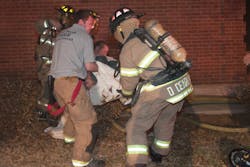Training to Search for Victims
The loud speaker opens with a a crackle and the dispatcher says "Stations and units respond for the structure fire with confirmed occupants trapped." If that statement does not get you up and focused, I do not know what would.
Searching for occupants trapped inside a fire is one skill that should be practiced by everyone on the fire department. Protecting life has long been the number one priority for all responders. Conducting an effective primary search is a skill that isn't practiced enough by many firefighters. Becoming disoriented and lost inside today's homes, that are filled to capacity with belongings, is a real danger faced when searching for victims. Let us take a few moments to review search tactics used when looking for trapped occupants.
Search line - having a pre-rigged search rope is a dependable means of staying oriented inside a structure. Many departments have them ready to use at a moment's notice. We must train with it constantly in order to deploy it quickly, safely, and without being tangled up in it.
Most search teams are comprised of two firefighters. This will allow the rope carrying firefighter to remain oriented while the other firefighter fans out to perform the search while remaining in voice contact. Using voice contact will allow the tag line to remain in a hallway while the rooms are searched. If the searching firefighter has a large room to search, the navigation firefighter may need to enter the room as well. This can complicate the operation when exiting as the slack will need to be managed while exiting.
The key point in this application is the management of the rope. If it is tangled, it will not offer the quick exit that may be needed if conditions worsen.
Wall search - the tried and true method of grabbing a wall and finding your way around the room seems to be the primary method taught to firefighters. While this search method may be the slowest, it offers a level of comfort to the searching firefighter as they have been trained on the skill set since the beginning of their time. Choosing to go left or right will allow you to stay in contact and turnaround if conditions deteriorate.
Some challenges with this method of searching are personal belongings or furniture that can push you away from the wall without realizing the difference. An oriented firefighter may find themselves in the middle of a room not knowing that they had lost contact with the wall. This can place you in the middle of trouble as you have lost all orientation to location.
Thermal imaging camera directed - Using technology seems to be the answer to all questions that come up these days. Using a thermal imaging camera (TIC) to direct searching firefighters seems to follow along with this thought. TIC advancements have made the quality of screens and detail amazingly easy to locate rooms layouts while searching for victims.
If you choose to use a TIC, which we all should, make sure you stay oriented by traditional means. Either remaining at the doorway, with a hand on a wall, or using a a search line will keep you oriented in the case of TIC failure or smoke conditions get thicker and darker, making it impossible to see the screen. With the solidified petroleum products that are burning inside buildings these days, smoke can become so thick and dark seeing the screen will be impossible.
If you are called upon to rescue an occupant from a building on fire, will you be ready? Crawling through the labyrinth of belongings can challenge the most experienced firefighters. Staying oriented while searching seems to be a bigger challenge than ever. We should spend time practicing each method in the event that the one you are most comfortable with is not an option. Take the time to review with your crews so we all go home safe.
Bunker up, buckle in, it's where we all begin!
- See Ryan Live! Blogger Ryan Pennington will be presenting "Hoarder Homes: Piles of Hazards for Firefighters" at Firehouse Expo in Baltimore, July 23 - 27.
